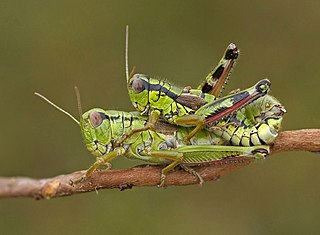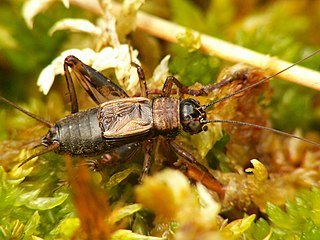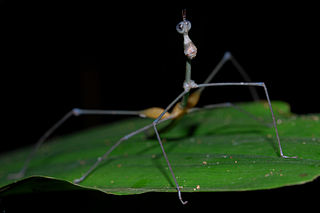
Tetrigidae is an ancient family in the order Orthoptera, which also includes similar families such as crickets, grasshoppers, and their allies. Species within the Tetrigidae are variously called groundhoppers, pygmy grasshoppers, pygmy devils or "grouse locusts".

Tree crickets are insects of the order Orthoptera. These crickets are in the subfamily Oecanthinae of the family Gryllidae.

Acridoidea is the largest superfamily of grasshoppers in the order Orthoptera with species found on every continent except Antarctica.

The Eneopterinae are a subfamily of crickets, in the family Gryllidae, based on the type genus Eneoptera. It is one of several groups widely described as "true crickets". Of the more than 500 species that make up this subfamily, most occur in moist, tropical habitats. These insects are medium to large and brown or gray in color. They eat plant leaves, flowers, and fruits and can occasionally cause economic damage. Their eggs are deposited in pith, bark, or wood. Eneopterinae show a great diversity in stridulatory apparatus, signals emitted, and associated behaviour.

Proscopiidae is a family of Neotropical grasshoppers, now placed in its own superfamily, the Proscopioidea. Some species may be known as stick grasshoppers or jumping sticks.

Nemobiinae is a subfamily of the newly constituted Trigonidiidae, one of the cricket families. The type genus is Nemobius, which includes the wood cricket, but members of this subfamily may also be known as ground crickets or "pygmy field crickets".
Hygronemobius is a genus of insect in family Gryllidae.
Kevanemobius is a genus of insect in family Gryllidae.
Phoremia is a genus of insect in family Gryllidae.

Anurogryllus, commonly known as short-tailed crickets, is a genus of crickets in the tribe Gryllini; species are recorded from the Americas. The common and scientific names derive from the vestigial, poorly developed ovipositors of females.

Agraeciini is a large tribe of bush crickets or katydids in the conehead subfamily, Conocephalinae.

The Trigonopterygoidea are an insect superfamily in the Orthoptera: Caelifera. Sometimes described as leaf grasshoppers, American species in the Xyronotidae have also been called razor-backed bush-hoppers.

Miogryllus is a genus of crickets in the subfamily Gryllinae, in the family Gryllidae and tribe Gryllini. Members of the genus Miogryllus are called striped crickets, also lesser field crickets. There are two North American species of Miogryllus, Miogryllus lineatus, the western striped cricket, and Miogryllus saussurei, the eastern striped cricket.
Hybusa is a genus of neotropical stick-mimicking grasshoppers, the only genus in the subfamily Hybusinae. They are herbivorous.

Proscopiinae is a subfamily of grasshoppers in the family Proscopiidae. There are more than 20 genera and 190 described species, found in South America.
Phalangopsis is a Neotropical genus of crickets in the family Phalangopsidae, subfamily Phalangopsinae, tribe Phalangopsini.
The Landrevinae are a subfamily of crickets, in the family Gryllidae, based on the type genus Landreva. They are terrestrial, omnivorous and may be known as "bark crickets"; genera are distributed in: Central and South America, Africa, tropical Asia, Korea, Japan, Australia and the Pacific Islands.

Modicogryllini is a tribe of crickets in the family Gryllidae. Species are terrestrial, carnivorous or omnivorous and can be found in all continenents except Antarctica.

Gryllini is a tribe of crickets and typical of the family Gryllidae. Species are terrestrial, carnivorous or omnivorous and can be found in all continenents except Antarctica.
Luzarinaeis a subfamily of crickets in the family Phalangopsidae.












